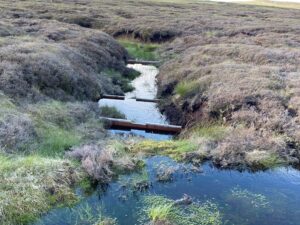New official trees and peat guidance supports grouse moors' strategy
- Rob Beeson

- Jul 14, 2021
- 2 min read
Updated: Jan 15
The strategy of grouse moor managers to avoid planting trees on peatland has been supported by new official guidance that acknowledges trees can damage peatlands.
A framework for establishing new woodland issued by the Forestry Commission, Forest Research and Natural England reaffirms the importance of healthy peatlands to aid carbon capture.
The guidance advises that crucial peatland habitats should not be planted with trees, to avoid loss of stored carbon. Peatlands are the largest terrestrial carbon store in England.
The Moorland Association welcomed the new guidance, as its members have already taken the lead in UK peatland restoration, making a valuable contribution of 26 per cent towards the government’s target for 2025.
Amanda Anderson, director of the Moorland Association said: “This guidance highlights the fact that healthy peatland provides a range of ecosystem services, including significant carbon sequestration and high biodiversity. We are all for the right tree in the right place – but, by and large, peatlands are not the right place. This new guidance supports the strategy employed by grouse moor managers.
“Grouse moors are already making a huge contribution to carbon capture through peatland restoration. Most recent work conducted by our members is equivalent to removing 61,126 tonnes of CO2 emissions from the atmosphere per year.
“This decision support framework strongly indicates drainage as the cause of peatland to become dry, eroded and emit carbon, something land managers have been aware of for decades. Our members have blocked up over 7000km of ill-advised historical agricultural drains. Putting more drainage in to allow trees to grow would be highly detrimental for greenhouse gas emissions and the resilience of our moors to wildfires.
The guidance also highlights that ‘Peatland restoration targets are of equal importance to those for tree planting’. There shouldn’t be a conflict between trees and peat. Indeed, we have planted 1,275 hectares of trees in the past ten years, but only in appropriate areas off peat soils. It’s a question of planting the right trees, in the right place, at the right density.”
Other independent research reports have reached the same conclusion – that tree planting on peatland ecosystems will aerate the peat, releasing stored carbon into the atmosphere.
The new guidance recommends that trees should not be planted within 100 metres of the boundary of a protected site, such as a Special Area of Conservation or a Site of Special Scientific Interest, increasing to 1,000m if that site is protected for open habitat birds. Ninety per cent of Moorland Association members’ land carries a designation; either National Park, Area of Outstanding Natural Beauty, Site of Special Scientific Interest, Special Area of Conservation or Special Protection Area, many of which are also protected for the precious bird life they support. Options for tree planting will therefore be limited.
Blanket bog, purple moor grass and rush pasture, grass moorland and upland heath are all priority habitats defined in the NERC Act 2006 and listed in Natural England’s List of Habitats of Principle Importance – all of these are typical habitats found on grouse moors that must be protected.




